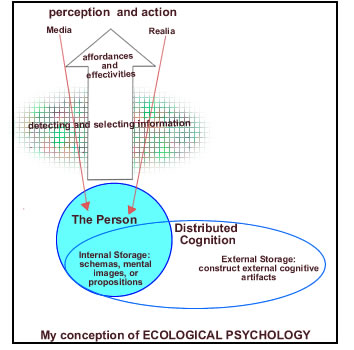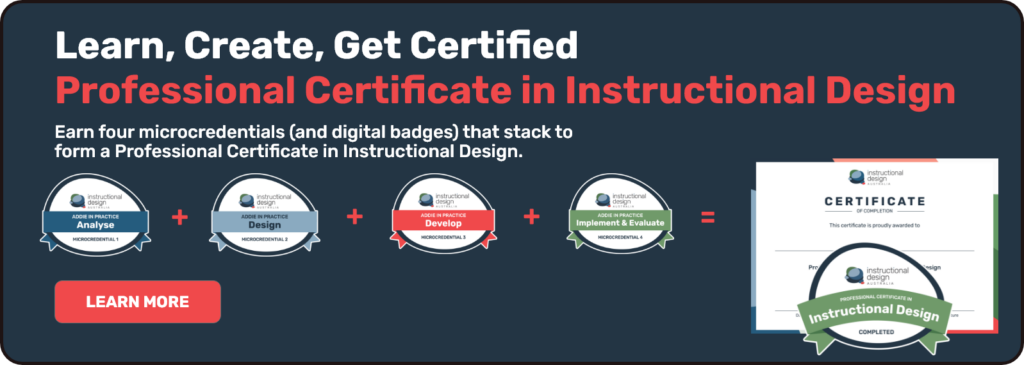Ecological psychology and Cognitive theory
Written by Annette Devilee – prepared as part of the assessment for her Master of Learning Science and Technology (MLS&T) at The University of Sydney. 2008.
Introduction to the Learning Sciences
Part A: Identification of the main elements that make the EP (ecological psychology) position different from CT (cognitive theory).
CT introduced the idea of internal mental representations. These are organised into schemata (the repositories for experiences) and mental models (specifies causal actions). EP refers to this “internal representational space” as MIROS (Mental-Internal Representations of Situations). Neisser (1991) saw schema as something more than just a template for experience, he regarded them as a plan for action. Allen, Otto, & Hoffman (2004) refer to this as actionable mental models for they see that our perceptions and actions are directly influenced by our evolving internal mental representations. This will influence the way we filter what we perceive from the environment and the way we will respond to the environment. Mental models of EP can not be studied independently of the situation for they can not operate outside the context of the model.
CT did not distinguish between different forms of experience so they treated all experiences equally. EP distinguishes between two forms of sensory stimuli: realia and media. Gibson’s (1979) used the term mediated perception when perception is facilitated by some tool such as pictures, text or video that represent something in reality. Perception according to EP can be broken down into direct or indirect. In other words, our observations by our senses are supplemented by artificial techniques or tools. Symbols are an example of indirect perception. Gibson coupled perception and action and introduced the terms affordances and effectivities. A simple way of explaining this is that as we perceive an object we also see an opportunity or the capability for action; a glass of water gives us the opportunity to drink, it has the capability to be drunk.
Zhang and Norman (1994) clearly explained our ability to distribute our representations of ideas or situations: distributed cognition. They describe how we can store our experiences internally (schemas, mental images, or propositions,) or externally (physical symbols and external rules or constraints embedded in physical configurations.). We can outsource to no biological systems such as hard drives, diaries, databases etc. Norman (1993) referred to these as external cognitive artifacts which he saw as giving us a way to “compensate for the limitations of our working and long-term memories”. We have the ability to construct external cognitive artifacts and to use these artifacts to compensate for the limitations of our working and long-term memories. This idea of externalisation or outsourcing can be applied to processing information as well as storing information. Hawkins (1964) saw this as very efficient but I think his ideas of Thermodynamic Efficiency of Externalization treat this process in a rather mechanical rather than humane way.

Learning under the CT is the modification of schemata or construction of new schemata as we accommodate new experiences. Although EP sees learning as a function of changing information content and structures, the way we organise our information representations is quite different from the CT model. In EP learning is focused on interactions with the environment, and our adaptation to the environment. EP considers learning as our attunement to constraints and detection of invariance in the environment. This process of identifying reliable patterns of change in the environment simplifies the tasks of perception and action; it allows us to spot the less predictable events or elements in the environment.
In CT the process of becoming an expert is about practice with feedback, quantitative and qualitative changes to the organisation of information (chunking) and repetition beyond mastery in order to make information retrieval automatized. EP regard the development of expertise as practice and familiarity that will eventually lead to automaticity, thus freeing up the mind to learn new skills at a higher level. An expert does not have to remember everything but they need to know when to remember something or when to use a tool or to store externally, when to process information themselves or when to use a tool to do the processing. I see the two theories are quite similar on this issue but use different terminology to explain it.
Part B
I have chosen to apply these theoretical concepts to a web site that I found useful when teaching a unit called “The Software Developers view of the Hardware”. We began by using one web page from the student intranet site that I made. This page acted as the index to several resources I used for this unit. One of these resources was copied from a textbook so we could all look at it on the screen with the data projector. This Intranet page had a hyperlink to a site about Logic Gates: the building blocks of digital circuits. This site is called Introduction to Logic Gates
If you take a look at this page on the AND Gate you will see that you can interact with the diagram to test different inputs to the logic gate.
- This site is an external cognitive artifacts because it is an object that results from human activity and it represents real logic circuits. It is a representation of a real logic gates found in computer chips. It shows literally what is happening in a single tiny gate that is not normally visible to the eye. This is an example of our perception being augmented by the media.
- The sensory stimuli in this case is media not reality. It is multi-media for it contains text and pictures. Perception is mediated or facilitated by the computer and the data-projector which become the tools for perception. The pictures and text also mediate our perception.
- On each page we see an opportunity (affordance) to interact with the site. It can be a navigation button or a drop-down menu. Elements of the menue allow us to choose a particular input to the logic-gate diagram. The page is capable (effectivities) of calculating (action) the result. This is achieved by the use of JavaScript to act on the change of menu item.
- Learning is focused on interactions with the drop-down menu and navigation buttons. The actionable mental models that can be produced is “If I select this input to the circuit, I will get a particular output”.
- Once you get the hang of the first page you know immediately what to do on the other pages. The process of identifying what to do with the first logic gate diagram, simplifies the tasks of perception and action when you go to the other pages to learn about more complex logic gates. This graduated progression from simple logic gate to more difficult gate allows us to spot the less predictable events or elements in the environment.
These theoretical concepts are useful in the analysis of learning environments. Students enjoyed the visual stimulation of this material more than only an explanation by me. Their performance and understanding also improved when I introduced the use of this interactive website. I chose to outsource my delivery of this unit by using the Internet as my tool to augment my instructions. It freed me up to focus on other issues such as classroom management and encouraging classroom discussion on the topic.
References
- Allen, B. S., Otto, R. G., & Hoffman, B. (2004). Media as lived environments: the ecological perspective of educational technology. In D. H. Jonassen (Ed.), Handbook of Research on Educational Communication and Technololgy (2 ed., pp. 215-242). Mahwah, NJ: Lawrence Erlbaum. (PDF)
- Winn, W. (2004). Cognitive perspective in psychology. In D. H. Jonassen (Ed.), Handbook of Research on Educational Communication and Technololgy (2 ed., pp. 79-112). Mahwah, NJ: Lawrence Erlbaum. [pdf)

